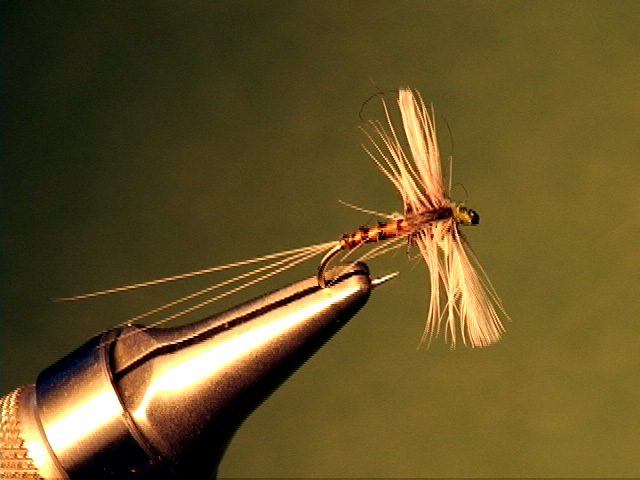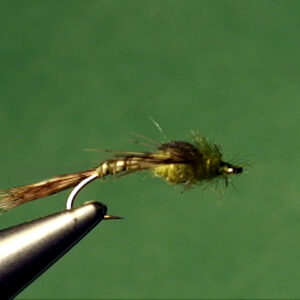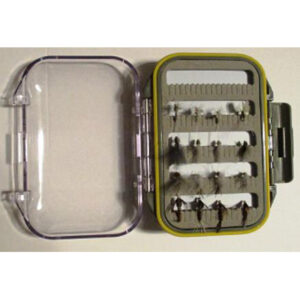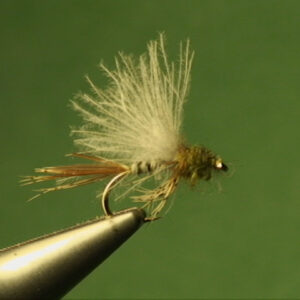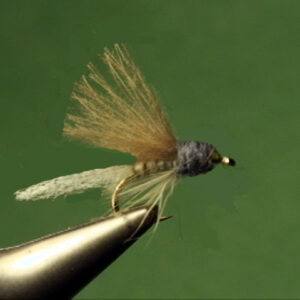Hook Size: 14/16/18/20
The Perfect Fly Blue Wing Olive Spinner is a imitation of the spinner stage of life of the mayfly. Once the dun reaches the banks, trees or bushes, it molts into a spinner, or the sexually mature adult. The males and females return to the water and mate in mid air, and eventually fall dead on the surface of the water where trout can easily dine on them. It should be fished on the surface and treated with floatant.
Some anglers consider the spinner of little or no importance, not having seen spinner
falls of Blue-winged Olives in great numbers. Others fish them successfully. Spinner falls
depends greatly upon the specific water involved but is directly comparable in size to the
hatch.
The female Blue-winged Olive spinners deposit their eggs two or maybe even three
different ways. They deposit them on the surface; crawl down rocks and plant stems to
deposit them; or dive and deposit them on objects below the surface of the water. This
probably varies as to species and may vary depending on the type of water and time of
the year. I don’t think anyone has pinpointed the particular method these mayflies use as
to species for certain. We think most trout eat the spent Blue-winged Olive spinners
drifting in the surface skim.
Normally the spinner fall occurs anywhere from mid-afternoon up until the time it’s
completely dark. The early season spinner falls tend to occur earlier in the day than the
late season spinner falls.
Spinner Presentation:
In smooth flowing water, you may be able to spot the trout sipping the spinners from the
surface of the water. In rough, fast flowing water, this is just about impossible. Normally,
if the Olives are crawling down objects to deposit their eggs, they do so in shallower,
calm water. You would probably not be able to spot the trout taking the spinners below
the surface; however, there’s always the possibility the trout are taking the spent
spinners that have collected in the eddies and along the banks in calm pockets of water.
If you are fishing the Perfect Fly Blue-winged Olive spinner, a spent imitation, you are
probably going to need to use a long, light leader and tippet. A ten or twelve-foot long
combined leader and 6X tippet would be a typical setup for this.
All in all, we have had mixed results from the Blue-winged Olive spinner falls depending
on the time of year, the particular species of Blue-winged Olive and the type of water we
fished. Spinner falls from the late season hatches have brought us better results than the
early season hatches. This may only be due to the fact the afternoons are much longer
and the weather is usually more stable than it is in the early season. In smooth water, we
have watched large trout sipping the spinners from the surface when they ignored our
imitations. Every once in a while, we were able to hook one of the larger fish, but most of
the time we ended up with a smaller size rainbow on the line. Catching spinner sipping
trout in the fast moving but smooth, slick water isn’t easy. It requires an good
presentation and a very good imitation of the spinners. Our Perfect Fly is the best
imitation of the naturals we have ever seen.
We have caught trout using wet imitations of spinners but we are not positive that the
trout took the fly for a Blue-winged Olive spinner. They could have been
opportunistically feeding trout.
The smaller sizes of Blue winged Olive spinners are very difficult to see, especially in low
light conditions. This may account for the fact that many anglers think the spinner fall of
Little Olives is not very important. You can rig to imitate the spinner as a dropper behind
near the surface of a more visible dry fly. This is helpful in seeing the small flies. Let the
trail and error method determine which method you use.
Copyright 2013 James Marsh
